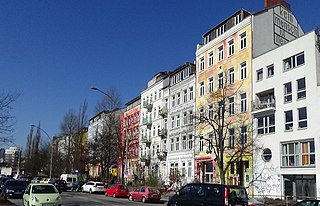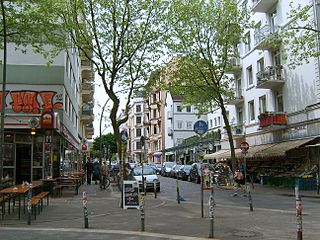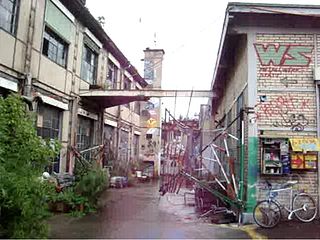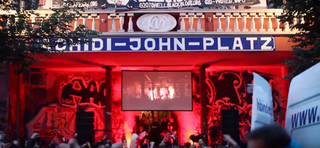
Hamburg, officially the Free and Hanseatic City of Hamburg, is the second-largest city in Germany, after Berlin, and 8th-largest in the European Union, with a population of over 1.9 million. The Hamburg Metropolitan Region has a population of over 5.1 million and is the ninth-biggest metropolitan region by GDP in the European Union.

Squatting is the action of occupying an abandoned or unoccupied area of land or a building, usually residential, that the squatter does not own, rent or otherwise have lawful permission to use. The United Nations estimated in 2003 that there were one billion slum residents and squatters globally. Squatting occurs worldwide and tends to occur when people find empty buildings or land to occupy for housing. It has a long history, broken down by country below.

Hafenstraße is a street in St. Pauli, a quarter of Hamburg, Germany, known for its legalized squats. The squats were occupied in 1981 and became a figurehead for autonomist and anti-imperialist politics. After a prolonged battle with the city council which involved demonstrations of over 10,000 people, the buildings were legalized in the 1990s. Today they are owned by a self-organised cooperative.

The Ernst-Kirchweger-Haus (EKH) is a self-managed social centre in Vienna's 10th district, Favoriten. It was squatted in 1990 and legalised in 2008. The project is named after Ernst Kirchweger.
Au is the name of a building that has been squatted since 1983 in Rödelheim in Frankfurt, Germany. It bills itself as a 'self-organised cultural Centre and living project'.

Warum geht es mir so dreckig? is the first album released by the German rock band Ton Steine Scherben. It includes—among other pieces—the song Macht kaputt, was euch kaputt macht, which expressed the built-up anger and radicalization of the youth of the late 1960s and early 1970s.

Rote Fabrik is a former factory in the Wollishofen neighbourhood of Zürich, Switzerland. It is now used as a music venue and cultural centre. It is so named because the buildings are made of red brick, but also because left-wing parties were part of the campaign to turn the location into a cultural centre.

The Hamburg protests were a large series of demonstrations in Hamburg, Germany, in December 2013 and January 2014.

Angela Roy is a German actress and director.

Sternschanze is a quarter in the center of Hamburg (Germany) within the Altona borough. In 2014, the population was 7,776 on an area of 0.6 km2 with a density of 14,113 inhabitants per km2. After Reeperbahn, it is Hamburg's best known entertainment and nightlife district. It is also known as Schanzenviertel and nicknamed Schanze.

The 2017 G20 Hamburg summit was the twelfth meeting of the Group of Twenty (G20), which was held on 7–8 July 2017, at Hamburg Messe, in the city of Hamburg, Germany.

Binz was a factory building squatted as a self-managed social centre in the district of Wiedikon in Zürich, Switzerland, from 2006 until 2013. The squat housed 50 people and provided workspaces for 100. From 2009 onwards, the city council wanted to evict and demolish the project. It was finally evicted in December 2013, resulting in riots.

Squatting in Spain refers to the occupation of unused or derelict buildings or land without the permission of the owner. In Francoist Spain migrant workers lived in slums on the periphery of cities. During the Spanish transition to democracy, residential squatting occurred in Spanish cities such as Barcelona, Bilbao, Madrid, Valencia and Zaragoza. From the 1980s onwards a new generation of squatters set up self-managed social centres which hosted events and campaigns. The 1995 Criminal Code among other things criminalised squatting, but failed to stop it. Social centres exist across the country and in Barcelona and Madrid in particular. In the Basque Country they are known as gaztetxes.
"Macht kaputt, was euch kaputt macht" is a 1970 song by German proto-punk band Ton Steine Scherben and a subsequent political slogan. Written in 1969, it first appeared as a single the next year, followed by the band's 1971 debut album Warum geht es mir so dreckig? The slogan was subsequently used in the German autonomous, squatting, and contemporary anarchist outgrowths of the 1960s West German student movement.

The death of Achidi John occurred while he was in police custody on December 12, 2001, in Hamburg, Germany, due to a combination of a serious heart defect, cocaine use, and the stress caused by emetics forcibly administered by police. Four days earlier, Achidi John had been forcibly administered an emetic to secure evidence of suspected drug trafficking against him. At the political level, the case led to a stop of emetics in Berlin and Lower Saxony. In Bremen, the Greens applied to end the practice of using emetics. The application was rejected. Bremen stopped the use of emetics in 2005 after the similar death of Laye-Alama Condé. In commemoration of the case, the place in front of the Rote Flora has unofficially been named Achidi John Square by left-wing groups.

Kulturzentrum Reitschule is a self-managed social centre at Neubrückstrasse 8 in Bern, Switzerland. It was first squatted in the 1980s and legalized after several evictions.

The Wasserwerfer 10000 is a water cannon used for riot control developed by Rosenbauer on the Mercedes-Benz Actros chassis for the Federal Police (Bundespolizei) and Bereitschaftspolizei in Germany. Named for its 10,000 litres (2,600 US gal) water capacity, it is the successor to the Wasserwerfer 9000.
The modern political squatting movement began in Hamburg, Germany, when Neue Große Bergstraße 226 was occupied in 1970. Squatters wanted to provide housing for themselves amongst other demands such as preventing buildings from being demolished and finding space for cultural activities. The Hafenstraße buildings were first occupied in 1981 and were finally legalized after a long political struggle in 1995. The still extant Rote Flora self-managed social centre was occupied in 1989. Squatting actions continue into the present; more recent attempts are quickly evicted, although the Gängeviertel buildings were squatted and legalized in the 2010s.

The Kulturzentrum Bremgarten (KuZeB) is a Swiss autonomous social centre and event venue that emerged from a former squat in 1992. It is located at Zürcherstrasse 2 in Bremgarten and is considered a symbolic place of the autonomous movement in the canton of Aargau as well as a meeting place for supra-regional social, cultural and politically motivated activities of the left-libertarians. Events of various kinds such as concerts, readings, discussions, information and counselling evenings take place regularly.



















